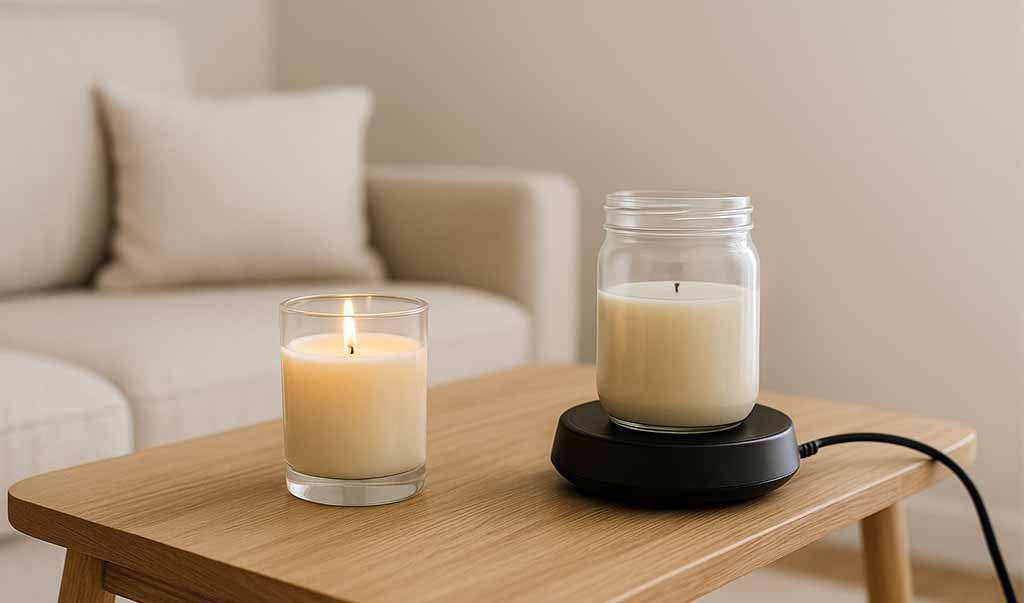Candle Warmer vs Lighting — if you love real flame ambiance and maximum hot throw, lighting a candle wins. However, if you want safer, low-maintenance fragrance without soot, a candle warmer is the smarter pick. Your room size, safety needs, and scent goals decide the rest.

Candle Warmer vs Lighting
| Factor | Lighting a Candle | Using a Candle Warmer |
|---|---|---|
| Ambiance | Real flame and cozy flicker; strong mood-setting | No flame; functional, steady background scent |
| Scent Throw | Typically stronger and faster due to higher localized heat | Often gentler and more even; best in small–medium rooms |
| Heat Source & Temp | Open flame; higher peak temps; quicker full melt pool | Plate/lamp heat; lower temp; needs a few minutes to bloom |
| Safety | Requires supervision; keep away from drafts and flammables | No open flame; still switch off/unplug when leaving for long periods |
| Residue / Air Quality | Possible soot/smoke if wick is long or airflow is strong | No soot, no smoke |
| Wax Consumption | Wax level drops as it burns | Wax may remain, but fragrance oils evaporate over time |
| Maintenance | Trim wick to ~5–6 mm; burn 2–4 h per session; monitor drafts | Minimal; replace candle/wax when scent fades even if wax remains |
| Cost & Energy | Consumes wax; no electricity | Uses electricity; stretches the jar’s visual life but fragrance still fades |
| Best For | Dinners, baths, photos, special evenings | Offices, dorms, rentals, homes with kids/pets, long steady sessions |
| Common Mistakes | Overlong wick; tunneling; burning near vents | Expecting flame-level throw; leaving on endlessly without refreshing |
| Pro Tips | First burn to the edge; use a snuffer; keep debris out of melt pool | Try plate vs lamp types; right-size the room; give it warm-up time |
WARNING: Never use a candle warmer and burn the same candle at the same time. That combination is extremely dangerous.
How Candle Warmers Work vs Lighting
Lighting a Candle: Ignite the wick to melt wax and diffuse fragrance. The open flame boosts diffusion and creates a full melt pool quickly.
Using a Candle Warmer: A plate or lamp gently heats the candle, releasing fragrance without combustion. As a result, it reduces fire risk and eliminates soot.
Pros
| # | Lighting a Candle — Pros | Using a Candle Warmer — Pros |
|---|---|---|
| 1 | Real flame ambiance and cozy flicker | No open flame; lower fire risk |
| 2 | Typically stronger, faster hot throw | No soot or smoke |
| 3 | Quick full melt pool; great diffusion | Stable, background scent for hours |
| 4 | Ritual feel; perfect for mood-setting | Simple to operate; minimal upkeep |
| 5 | Photo-ready for dinners/baths/events | Safer for offices, dorms, homes with kids/pets |
Cons
| # | Lighting a Candle — Cons | Using a Candle Warmer — Cons |
|---|---|---|
| 1 | Needs supervision; higher fire risk | Less ambiance; no flame effect |
| 2 | Can produce soot/smoke if misused | Fragrance fades even if wax remains |
| 3 | Consumes wax faster | Needs power outlet; device placement matters |
| 4 | Sensitive to drafts; tunneling possible | Lower peak throw in large/open rooms |
| 5 | Not ideal around kids/pets unattended | Easy to leave on too long if not mindful |
Safety Essentials
Never leave a lit candle unattended or sleep with it burning.
Place candles and warmers on a heat-resistant, stable surface away from drafts and curtains.
Keep both out of reach of children and pets.
Trim wicks to ~5–6 mm before each burn to reduce soot and mushrooming.
Ventilate the room and follow the manufacturer’s instructions.
Practical Tips for Better Results
For Lighting
First burn to the jar edge to help prevent tunneling.
Burn 2–4 hours per session; snuff, cool, and relight later.
Use a snuffer or dip-and-lift method to extinguish with minimal smoke.
For Candle Warmers
Start with one jar; if the room is large, consider a second warmer or choose a smaller space.
Give plate/lamp warmers several minutes to reach effective diffusion.
Replace the candle/wax when scent weakens, even if some wax remains.
FAQs:
Does a warmer make my candle last longer?
Often yes, because you’re not combusting wax. Nevertheless, fragrance oils still evaporate over time, so you’ll eventually refresh or replace the candle.
Why does my lit candle smoke sometimes?
Usually an overlong wick, drafts, or debris in the melt pool. Trim the wick and avoid airflow.
Can I warm any candle?
Most jar candles are fine. However, follow the manufacturer’s guidance and avoid non-heat-safe containers.
Why Your Candle Doesn’t Smell While Burning: https://highlyscent.com/why-does-my-candle-not-smell-while-burning/
How to Choose the Perfect Scented Candle for Every Room: https://highlyscent.com/how-to-choose-the-perfect-scented-candle-for-every-room/
Sustainability at HighlyScent: https://highlyscent.com/sustainability/
- National Fire Protection Association (candle safety): https://www.nfpa.org/
- U.S. Consumer Product Safety Commission (home product safety): https://www.cpsc.gov/
